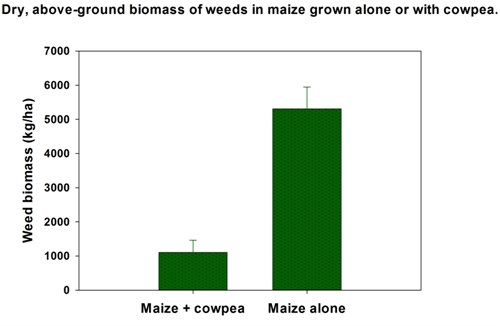This past growing season (April –Sept 2014) a maize/cowpea intercropping trial was conducted on ECHO’s Global Demonstration Farm in southwest Florida. Half of the plots were planted to maize alone; the remaining half consisted of alternating rows of maize and cowpea. During the first half of the growing season, until the maize canopy had developed, weeds were kept in check through hand-weeding. Towards the end of the growing season, weed growth had resumed, providing an opportunity to gather some data on how well cowea [(planted 0.6 (in row) X 1.0 m (between row)] suppressed weeds.

A rectangular wooden grid—about 0.6 square meters in size— was constructed that fit between two rows of maize. The grid was placed on the ground at one location in each plot, and any weeds within the inside edges of the grid were cut at ground level, dried, and weighed. As shown in the graph below, there was much less weed biomass with maize+cowpea (1104 kg/ha) than maize alone (5308 kg/ha).

During the winter season, we have been allowing guinea hogs to graze the field. They are kept in a small pen that is rotated around. They tend to leave the Spanish needle (Bidens alba) weeds, but they do consume and/or destroy a fair amount of weeds. In the photo below, notice the difference between weeds in the pen versus those surrounding the pen. Perhaps a “chicken tractor” would accomplish something similar. It would be interesting to compare a “chicken tractor” versus this “guinea hog tractor.”

In another part of the farm, we planted an area to a bush-type variety of velvet bean (Mucuna pruriens). Velvet bean grows very well during our hot, rainy (≈1500 mm ) summers. A thick canopy was established early in the season, shading out underlying weeds. Below is a photo showing the mulch resulting from dieback of the foliage over the winter season. Notice that there are not a lot of weeds coming through the mulch. Most of the live plants in the photo are velvet bean vines still alive but in decline. This observation is consistent with what we saw in ECHO research plots in South Africa—that tropical legumes with dense canopies (e.g., velvet bean, lablab and horsegram) effectively suppressed weed growth.

1 Like
I like this experience. I struggling to make it work as well under maize. But, I am worried that, maybe such an intercrop could reduce maize yield significantly! Any advice here before I go ahead with such a small trial? Did you try to collect grain yield for both Intercropped maize and maize mono? Thanks for an interesting finding you shared.
Thank you for your interest in experimenting with maize/legume intercropping. You are right to be concerned about a legume reducing yield of the cereal crop. This is most likely to happen when you have a fast-growing legume that climbs the stalks of underperforming maize plants. We have seen small yield reductions, for example, when the maize plants are not supplied with adequate fertility.
There are ways, however, to avoid such losses. Below are a few suggestions:
- Select legumes with vines that tend to stay close to the ground. Cowpea is less likely to climb than, say, lablab or velvet bean.
- Plant the legume about 2-4 weeks after the maize crop. In our experience, we have not seen maize yield reductions with maize and cowpea planted at the same time. I would suggest planting lablab 2 weeks after maize if you are planting in alternating rows. Lablab climbs, but it is also slow to establish; we have seen that lablab underperforms when planting more than 4 weeks after maize. Velvet bean should probably be planted about a month after maize. Velvet bean is not considered edible, but it produces an abundance of biomass that can benefit the soil.
- If the rainy season is long enough, plant your legume into the maize near maize harvest time. This works as long as there is still enough soil moisture at the end of the maize season to establish the legume.
- Try a different planting configuration. We have seen good results with 2 rows of maize being alternated with 4 rows of legume. Findings were summarized in EDN 140. This approach optimizes light availability for both the maize and the legume, while minimizing competition from high biomass-producing legumes. The tradeoff is less land devoted to maize, so it is best for areas where there is market demand for the legume grain.
Hopefully this gives you some ideas for moving forward. You are on the right track as far as experimenting on a small plot to validate an approach for your context.
2 Likes
Thank you for your advice. These are really helpful on my side. For example, I was struggling to know when exactly I have to plant a low growing cover crop in a maize field with the intention of reducing weeding pressure. I am putting this planting time in my execution plan. For sure I will share my findings here. and also I can understand the idea of planting a Cover crop when maize is close to maturity when rain is enough.



